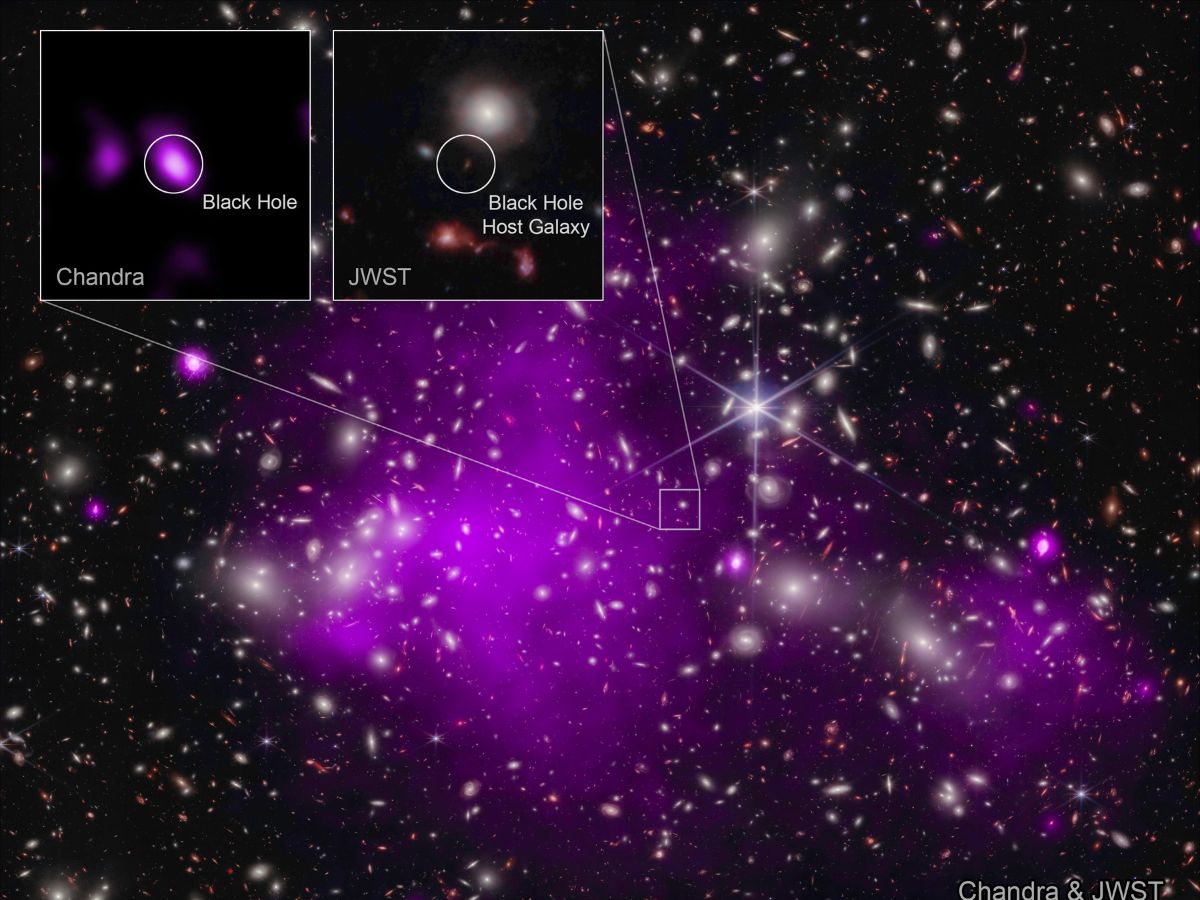NASA's Chandra X-ray And Webb Discover Most Ancient Supermassive Black Hole Observed In X-rays. SEE Pic
Chandra observed the black hole, while Webb observed the host galaxy, which is called UHZ1. This is located behind the galaxy cluster Abell 2744. Chandra observed it in X-rays and Webb in infrared.

NASA's Chandra X-ray and James Webb Space Telescope (Webb) have made observations which have allowed scientists to discover the most distant, and hence, the most ancient supermassive black hole in X-rays. Since the black hole is the most distant, the light from it will take longer to reach Earth than any other supermassive black hole, and as a result, people can witness the growth of the black hole in its early stages. In other words, it is like looking back into the past.
The mass of the distant black hole is similar to that of its host galaxy, NASA said on its website.
Since the black hole can be seen in its early stages of formation, the information can help scientists understand how the universe's first supermassive black holes were formed.
Scientists, by combining data from Chandra and Webb, have found the tell-tale signatures of this growing black hole from a time about 470 million years after the Big Bang.
Chandra observed the black hole, while Webb observed the host galaxy, which is called UHZ1. This is located behind the galaxy cluster Abell 2744.
Chandra observed Abell 2744 in X-rays and Webb observed it in infrared.
X-ray emissions indicate a growing supermassive black hole.

The study describing these findings was recently published in the journal Nature Astronomy.
In a NASA statement, Akos Bogdan of the Center for Astrophysics | Harvard & Smithsonian (CfA), who led the study, said Webb was needed to find the remarkably distant galaxy, and Chandra to find the supermassive black hole. The scientists leveraged a cosmic magnifying glass created through an effect called gravitational lensing to boost the amount of light detected.
Gravitational lensing is a phenomenon in which a foreground galaxy bends the light from a more distant object and magnifies it. The massive celestial body, such as a galaxy cluster, which causes a sufficient curvature of spacetime for the path of light around it to be visibly bent, as if by a lens, is called a gravitational lens.
MUST READ | Paralysis, Aphasia, Vision Problems — Physical Symptoms That May Arise After Stroke, And Why
Similarly, a black hole bends the light from the galaxy inside which it is present, as a result of which the galaxy is magnified, allowing scientists to observe it in enhanced detail.
Objects as massive as black holes can bend and distort light from more distant objects. Therefore, gravitational lensing helps scientists find isolated black holes that are otherwise invisible.
MUST READ | Science For Everyone: What Is Materials Transition, And How It Will Help Ensure A Net-Zero Future
How gravitational lensing helped scientists observe the host galaxy of the supermassive black hole
Abell 2744, the galaxy behind which UHZ1 is present, is located 3.5 billion light-years from Earth. UHZ1 is much more distant than Abell 2744, and is located 13.2 billion light-years from Earth, Webb data has revealed. The universe is 13.8 billion years old, and since the cluster is located 13.2 light-years from Earth, it means that light from the cluster observed by Webb is from a time when the universe was only about four per cent of its current age.
Chandra observed the black hole for over two weeks, and found intense, superheated, X-ray emitting gas in the galaxy. X-ray emitting gases are a signature for growing supermassive black holes.
Because of gravitational lensing, the light from UHZ1 was magnified by a factor of four, with Abell 2744 acting as a gravitational lens. Therefore, gravitational lensing enhanced the infrared signal detected by Webb from UHZ1. Also, Chandra was able to detect the faint X-ray source, which was the supermassive black hole.
MUST READ | Science For Everyone: What Is The Black Substance Found On Onions And Garlic? Know How This Can Be Managed
How could the supermassive black hole have been formed?
The significance of the discovery is that it will help scientists understand how some supermassive black holes can reach colossal masses in a short time span after the Big Bang. There could be many possibilities, including the fact that these supermassive black holes form directly after the collapse of massive clouds of gas. The collapse could create black holes that have masses between 10,000 to 100,000 times that of the Sun. Another possibility is that these black holes form from the explosions of the first stars, and weigh only about 10 and 100 Suns initially.
In the statement, Andy Goulding of Princeton University, a co-author on the paper published in Nature Astronomy, and the lead author of a new paper published in The Astrophysical Journal Letters on the galaxy's distance and mass. These parameters were found using a spectrum obtained by Webb.
The newly discovered black hole was born massive, according to Bogdan's analysis. Based on the brightness and energy of the X-rays, Bogdan's team has estimated that the mass of the black hole is between 10 and 100 million Suns.
MUST READ | Moon's Age Revealed By Lunar Crystals Brought Back By Apollo 17 Astronauts: Study
What is surprising about the most ancient supermassive black hole ever observed?
However, a surprising observation is that the mass range is similar to that of all the stars in the galaxy (UHZ1) in which the black hole lives. This is unusual because in the nearby universe, black holes in the centres of galaxies contain only about a tenth of a percent of the mass of a host galaxy star.
In 2017, Priyamvada Natarajan of Yale University, a co-author on the paper published in Nature Astronomy, made some theoretical predictions for an "Outsize Black Hole" that directly formed as a result of the collapse of a huge cloud of gas. According to NASA, the large mass of the black hole at a young age, the amount of X-rays it produces, and the brightness of the galaxy detected by Webb, agree with these theoretical predictions.
MUST READ | Oldest-Known Mega-Predatory Marine Reptile Revealed By Fossils Of 170-Year-Old Organism
In the statement, Natarajan said that the team thinks this is the first detection of an 'Outsize Black Hole' and the best evidence yet obtained that some black holes form from massive clouds of gas.
Natarajan also said that for the first time, researchers are seeing a brief stage where a supermassive black hole weighs about as much as the stars in its galaxy, before it falls behind.
The results, along with data from Webb, will help scientists obtain a larger picture of the early universe.







































